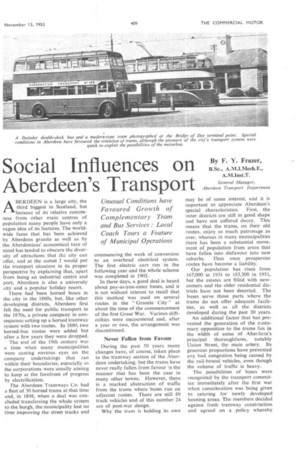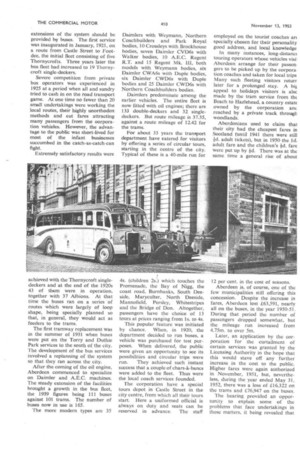Social Influences on Aberdeen's Transport
Page 121

Page 122

Page 123

If you've noticed an error in this article please click here to report it so we can fix it.
By F. Y. Frazer,
B.Sc., A.M.I.Mech.E., A.M.Inst.T.
General Manager, Aberdeen Transport Department
ABERDEEN is a large city, the third biggest in Scotland, but because of its relative remoteness from other main centres of population many people have only a vague idea of its features. The worldwide fame that has been achieved by Aberdeen granite as well as by the Aberdonians' economical turn of mind has tended to obscure the diversity of attractions that the city can offer, and at the outset I would put the transport situation in its proper perspective by explaining that, apart from being an industrial centre and port, Aberdeen is also a university city and a popular holiday resort.
There had been horsed buses in the city in the 1860s, but, like other developing districts, Aberdeen first felt the need for public transport in the 1870s, a private company in consequence setting up a horsed tramway system with two routes. In 1880, two horsed-bus routes were added but after a few years they were dropped.
The end of the 19th century was a time when many municipalities were casting envious eyes on thc company undertakings that ran within their boundaries, especially as the corporations were usually aiming to keep at the forefront of progress by electrification.
The Aberdeen Tramways Co_ had a fleet of 30 horsed trams at that time and, in 1898, when a deal was concluded transferring the whole system to the burgh, the municipality lost no time improving the street tracks and commencing the work of conversion to an overhead electrical system. The first electric cars ran in the following year and the whole scheme was completed in 1902.
In these days, a good deal is heard about pay-as-you-enter buses, and it is not without interest to recall that this method was used on several routes in the " Granite City" at about the time of the commencement of the first Great War. Various difficulties were encountered and, after a year or two, the arrangement was discontinued.
Never Fallen from Favour
During the past 50 years many changes have, of course, taken place in the tramway section of the Aberdeen undertaking, but the trams have never really fallen from favour 'n the manner that has been the case in many other towns. However, there is a marked abstraction of traffic from the trams where buses run on adjacent routes. There are still 89 track vehicles and of this number 24 are of post-war design.
Why the tram is holding its own may be of some interest, and it is important to appreciate Aberdeen's special . characteristics. First, the inner districts are still in good shape and have not suffered decay. This means that the trams, on their old routes, enjoy as much patronage as ever, whereas in many municipalities there has been a substantial movement of population from areas that have fallen into disfavour into new suburbs, Thus once prosperous routes have become a liability.
Our population has risen from 167,000 in 1931 to 183,300 in 1951, but the estates are filled with newcomers and the older residential districts have not been deserted. The buses serve those parts where the trams do not offer adequate facilities, as well as all the districts developed during the past 30 years.
An additional factor that has prevented the generation of the customary opposition to the trams lies in the width of some of Aberdeen's principal thoroughfares, notably Union Street, the main artery. Its generous proportions have prevented any bad congestion being caused by the rail-bound vehicles, even though the volume of traffic is heavy.
The possibilities of buses were recognized by the transport committee immediately after the first war when consideration was being given to catering for newly developed housing areas. The members decided against fresh tramway construction and agreed on a policy whereby
extensions of the system should be provided by buses. The first service was inaugurated in January, 1921, on a route from Castle Street to Footdee, the initial fleet consisting of five Thornycrofts. Three years later the bus fleet had increased to 19 Thornycroft single-deckers.
Severe competition from private bus operators was experienced in 1925 at a period when all and sundry tried to cash in on the road transport game. At one time no fewer than 20 small undertakings were working the local routes, their highly unorthodox methods and cut fares attracting many passengers from the corporation vehicles. However, the advantage to the public was short-lived for most of the infant businesses succumbed in the catch-as-catch-can fight.
Extremely satisfactory results were achieved with the Thornycroft singledeckers and at the end of the 1920s 43 of them were in operation, together with 37 Albion& At that time the buses ran on a series of routes which were largely of loop shape, being specially planned so that, in general, they would act as feeders to the trams.
The first tramway replacement was in the summer of 1931 when buses were put on the Torry and Duthie Park services to the south of the city. The development of the bus services involved a replanning of the system so that they ran across the city.
After the corning of the oil engine, Aberdeen commenced to specialize on Daimler and A.E.C. machines. The steady extension of the facilities brought a growth in the bus fleet, the 1939 figures being 111 buses against 101 trams. The number of buses now in use is 165.
The more modern types are 35 Daimlers with Weymann, Northern Coachbuilders and Park Royal bodies, 10 Crossleys with Brockhouse bodies, seven Daimler CVD6s with Walker bodies, 10 A.E.C. Regent R.T. and 15 Regent Mk. 111, both models with Weymann bodies, six Daimler CWA6s with Duple bodies, six Daimler CWD6s with Duple bodies and 25 Daimler CWD6s with Northern Coachbuilders bodies.
Daimlers predominate among the earlier vehicles. The entire fleet is now fitted with oil engines; there are 133 double-deckers and 32 singledeckers. But route mileage is 37.35, against a route mileage of 12.42 for the trams.
For about 33 years the transport department have catered for visitors by offering a series of circular tours, starting in the centre of the city. Typical of these is a 40-mile run for 4s. (children 2s.) which touches the Promenade, the Bay of Nigg, the coast road, Burnbanks, South Deeside, Maryculter, North Deeside, Mannofield, Persley, Whitestripes and the Bridge of Don. Altogether, passengers have the choice of 13 tours at prices ranging from ls. to 4s.
This popular feature was initiated by chance. When, in 1920, the department decided to run buses, a vehicle was purchased for test purposes. When delivered, the public were given an opportunity to see its possibilities and circular trips were run. They achieved such instant success that a couple of chars-a.-bancs were added to the fleet. Thus were the local coach services founded.
The corporation have a special tours depot in Castle Street in the city centre, from which all their tours start. Here a uniformed official is always on duty and seats can be reserved in advance. The staff employed on the tourist coaches art specially chosen for their personality good address, and local knowledge In many instances, long-distanct touring operators whose vehicles visii Aberdeen arrange for their passengers to be picked up by the corporation coaches and taken for local trips Many such fleeting visitors returr later for a prolonged stay. A biE appeal to holidays visitors is alsc made by the tram service from thc Beach to Hazlehead, a country estatt owned by the corporation anc reached by a private track through woodlands.
Aberdonians used to claim that their city had the cheapest fares in Scotland (until 1941 there were still id. adult tickets), but in 1950 the ld, adult fare and the children's id. fare were put up by id. There was at the same time a general rise of about 12 per cent. in the cost of seasons.
Aberdeen is, of course, one of the few municipalities still offering this concession. Despite the increase in fares, Aberdeen lost £63,591, nearly all on the buses, in the year 1950-51. During that period the number of passengers dropped somewhat, but the mileage run increased from 4.75m. to over 5m.
Later, an application by the corporation for the curtailment of certain services was granted by the Licensing Authority in the hope that this would stave off any further increase in the cost to the public. Higher fares were again authorized in November, 1951, but, nevertheless, during the year ended May 31, 1952, there was a loss of £16,322 on the trams and £76,947 on the buses.
The hearing provided an opportunity to explain some of the problems that face undertakings in these matters, it being revealed that wages had increased by £500 a week in the period between making the application and its hearing.
During 1952-53 the Aberdeen bus mileage was 5,478,771 and the passengers carried numbered 72,164,032. Average traffic revenue per bus-mile was 26.099d., whilst working expenses average 25.576d. Passengers represented 13.17 per busmile and the average fair paid per passenger journey was 1.981d. Speeds worked out at 10.8 m.p.h. and the average miles per bus per day were 117.268 The average fare charged per mile was 1.22d.
In Aberdeen there are three daily peak periods, 8-9 a.m., 12 noon-2 p.m., and 4.30-6 p.m. At these times some 96 per cent, of the fleet are always in use. During the war an increasing proportion of the country's population became accustomed t o eating the mid-day meal in canteens or restaurants, but in Aberdeen there is still a strong feeling in favour of home cooking. Most workers return to their families for lunch, with the result that transport is pressed just as heavily then as in the morning and evening rushes.
On both buses and trams the T.I.M. and Ultimate ticket-issuing machines are employed. The Aberdeen livery is green and cream, and bodies are repainted every three years.
Buses are garaged at depots at King Street, Mannotield Road and Canal Road, and the trams at Queen's Cross. A small bus depot at Constitution Street has recently been closed in the interests of economy.
Maintenance arrangements provide for daily reports by the drivers on troubles that have arisen in the course of their turn of duty and inspections are made nightly. An Essex bus washer is used and washing takes place every two days. Chassis are greased every two weeks. The undertaking's system provides for light docks at intervals of 5,000 miles, medium docks at 50,000 miles and overhauls at 100,000 or 130,000 miles according to type.
The total staff of the department is 1,452, there being 33 inspectors, 298 bus drivers, 163 tram drivers and 500 conductors There are no staff .shortages in Aberdeen and, in consequence, conductresses are no longer employed. by the transport undertaking.












































































































































































































































